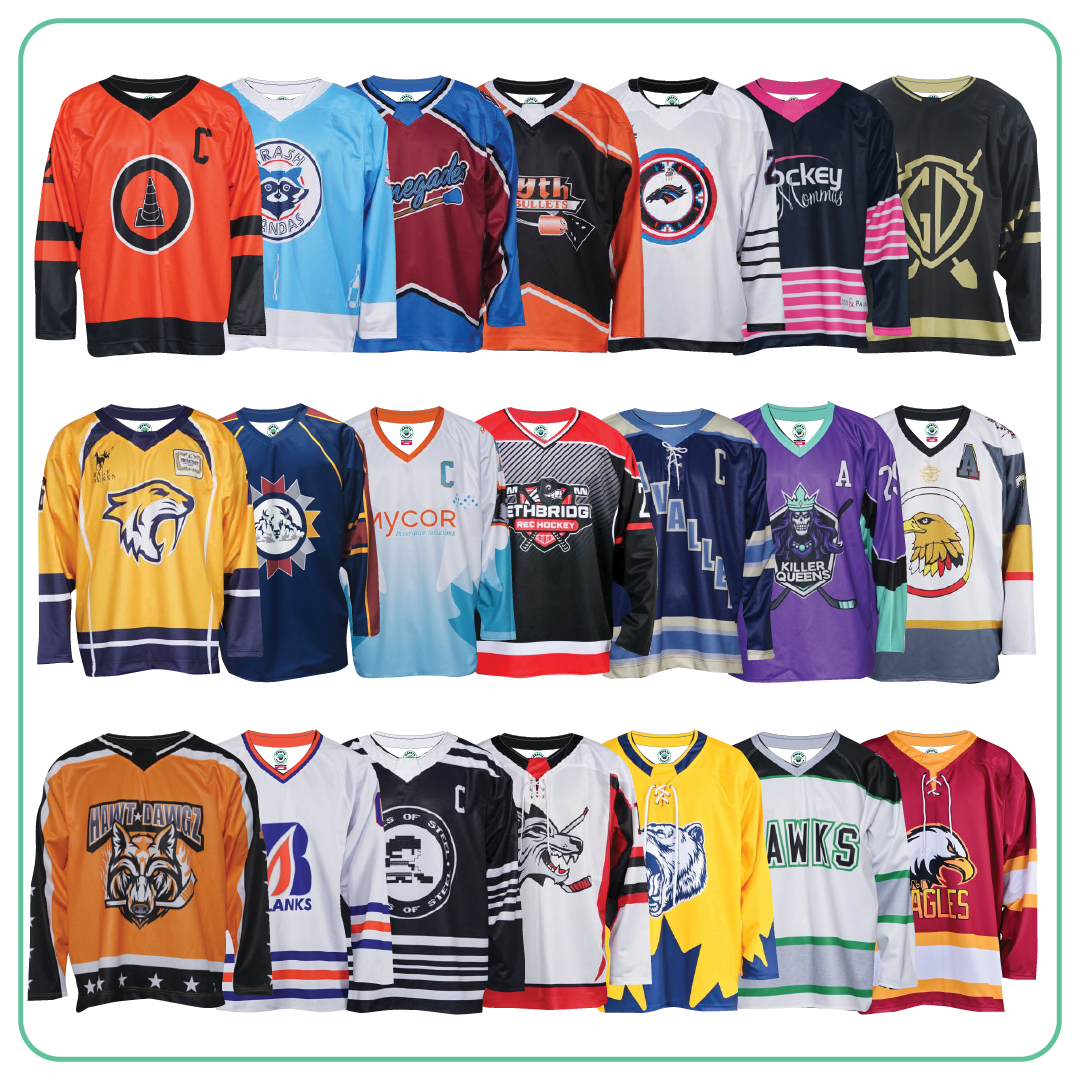Are Hockey Jerseys Waterproof? Hockey jerseys are not waterproof. They are designed to be breathable and wick moisture away from the body.
Hockey jerseys, a crucial part of a player’s gear, are crafted from durable materials to withstand the game’s rigours. These jerseys are not just about durability; they are designed to keep players comfortable and enhance their performance. Their ventilation and moisture-wicking properties effectively manage sweat, providing flexibility and a reassuring level of comfort. While they are not waterproof, they are a testament to the quality and thoughtfulness put into their design.
Proper care and maintenance can extend the lifespan of a hockey jersey. Players can make informed decisions about their gear by understanding the materials and design. Investing in a quality jersey ensures better performance and comfort on the ice.
The Fabric Of The Game
Hockey jerseys are essential for players. The fabric must be durable and comfortable. Are hockey jerseys waterproof? Let’s explore the materials and technology used.
Materials Used In Hockey Jerseys
Hockey jerseys use various materials. The most common ones include:
- Polyester: Lightweight and durable
- Nylon: Strong and resistant to wear
- Spandex: Adds flexibility and stretch
These materials ensure comfort and performance and help manage moisture. Hockey players sweat a lot, so the fabric must handle it.
Technological Advances In Fabric
Technology has improved hockey jersey fabrics. They are now more advanced than ever. Some key technologies include:
- Moisture-Wicking: Keeps players dry by moving sweat away
- Breathability: Allows air to circulate, keeping players cool
- Antimicrobial: Reduces odour-causing bacteria
Do you know if these jerseys are waterproof? Not entirely. They are water-resistant, which means they can handle some moisture but are not fully waterproof. This design helps maintain comfort and performance.
Water Resistance Vs. Waterproof
Hockey jerseys are essential gear for players. They are often exposed to sweat, water, and ice. The terms water resistance and waterproof are frequently used. But what do they mean for hockey jerseys? Let’s dive into the key differences and debunk some myths.
Key Differences
Water resistance means the jersey can repel some water so that it won’t get soaked quickly. Waterproof means the jersey is impervious to water, so no water can penetrate it.
| Feature | Water resistant waterproof | f |
|---|---|---|
| Protection Level | Partial | Complete |
| Material | Repellent Coating | Impermeable Fabric |
| Usage | Light Exposure | Heavy Exposure |
Myths Debunked
- Myth: All hockey jerseys are waterproof.
Fact: Most are only water-resistant. - Myth: Water resistance means complete protection.
Fact: Water resistance offers limited protection. - Myth: Waterproof jerseys are uncomfortable.
Fact: Modern waterproof jerseys are breathable and comfy.
Hockey Jerseys In Action
Hockey jerseys play a crucial role during matches. Players face tough conditions on the ice, and these jerseys need to withstand various challenges. Let’s explore how they perform.
Exposure To Elements
Hockey jerseys encounter many elements. Players sweat a lot during games. The jerseys get wet from sweat. They also face moisture from the ice. Sometimes, players fall and slide on the ice. This adds water to their jerseys. Additionally, arenas can be cold and damp. The jerseys need to handle this cold and moisture.
Performance On Ice
Hockey jerseys must perform well on ice. They should remain light even when wet. Heavy jerseys can slow players down. The fabric should dry quickly. This helps players stay comfortable. A wet jersey can cause discomfort. It can also lead to chills in cold arenas. The jersey’s material is important. Modern jerseys use synthetic fabrics. These are better at handling moisture.
| Element | Impact on Jersey |
|---|---|
| Sweat | Increases weight, causes discomfort |
| Ice Moisture | Can make jerseys wet and cold |
| Cold Arenas | Jerseys can get damp and chilly |
- Sweat: Jerseys must wick away sweat.
- Ice Moisture: Jerseys should resist water from ice.
- Cold Arenas: Jerseys need to provide warmth.
- Use moisture-wicking fabrics.
- Ensure quick-drying properties.
- Maintain lightweight even when wet.
Credit: jerseysmadeeasy.com
Player Comfort And Equipment Design
Hockey players need comfort and freedom to move. Their jerseys play a big role in this. But are hockey jerseys waterproof? Let’s explore this through their design and features.
Breathability Concerns
Breathability is key for player comfort. If a jersey traps sweat, players feel sticky and uncomfortable. Modern jerseys use special fabrics.
- Mesh panels under the arms
- Ventilation zones on the back
These features allow air to flow. This keeps players cool and dry.
Moisture Management Features
Moisture-wicking technology pulls sweat away from the skin. This fabric dries quickly. It prevents the jersey from getting heavy with sweat.
Some jerseys have water-resistant coatings. These coatings keep rain and snow off. But they still let sweat escape.
| Feature | Benefit |
|---|---|
| Moisture-wicking | Keeps players dry |
| Ventilation zones | Improves breathability |
| Water-resistant coating | Repels rain and snow |
These features ensure player comfort and performance. Comfortable players can focus better on the game.
Maintenance And Care
Maintaining and caring for your hockey jersey ensures it lasts long. Proper care enhances its appearance and performance. Below are essential tips for cleaning and preserving your jersey.
Cleaning Practices
Proper cleaning is crucial for your hockey jersey. Follow these steps for best results:
- Always check the care label before washing.
- Wash in cold water to prevent colors from fading.
- Use a gentle detergent to avoid damaging the fabric.
- Turn the jersey inside out to protect logos and numbers.
- Avoid bleach and fabric softeners as they can harm the material.
For stubborn stains, spot-treat using a mild soap. Could you gently rub the stained area with a soft cloth? Rinse thoroughly with cold water. Never use hot water as it can shrink the fabric.
Enhancing Longevity
Proper handling can significantly extend the life of your hockey jersey. Here are key tips:
- Air dry the jersey instead of using a dryer. Heat can damage the fabric.
- Store the jersey in a cool, dry place. Avoid direct sunlight.
- Hang the jersey rather than folding it. This prevents creases and wrinkles.
- Avoid ironing on printed areas. The heat can cause peeling and cracking.
- Rotate jerseys if you own multiple. This reduces wear and tear on a single jersey.
By following these maintenance tips, you ensure your hockey jersey stays in top condition. Proper care not only keeps it looking great but also enhances its durability and performance.
Innovations In Hockey Apparel
Hockey jerseys have evolved over the years. New technologies make them more durable and functional. This section explores the latest innovations in hockey apparel.
Cutting-edge Materials
Modern hockey jerseys use advanced materials. These materials are designed to be lightweight and breathable.
| Material | Feature |
|---|---|
| Polyester | Lightweight and quick-drying |
| Spandex | Stretchy and form-fitting |
| Water-resistant coating | Repels water and moisture |
These materials make the jerseys more comfortable. Players stay dry and cool during intense games.
Future Of Jersey Design
The future of hockey jersey design looks promising. Designers focus on improving performance and style.
- Smart fabrics: Materials that regulate temperature and moisture.
- Custom fits: Tailored jerseys for better mobility.
- Eco-friendly options: Sustainable materials for a greener future.
These innovations aim to enhance player experience. Hockey jerseys will become more advanced and efficient.
The Impact Of Weather Conditions
Weather conditions can greatly affect hockey games and gear. Players need to adapt to various climates to perform well. Different weather types pose unique challenges for the players and their equipment.
Outdoor Games Challenges
Outdoor hockey games face many challenges due to weather. Rain and snow can make the ice surface slippery and unpredictable. Players may find it harder to skate and control the puck.
Wind is another big challenge. Strong winds can affect the flight of the puck. It can also make players feel colder, impacting their performance.
Sunlight can be a problem, too. Bright sun can cause glare on the ice, making it hard to see. It can also lead to melting ice, which affects skating.
| Weather Condition | Challenge |
|---|---|
| Rain | Slippery ice, hard to control puck |
| Snow | Slippery ice, visibility issues |
| Wind | Affects puck flight, feels colder |
| Sunlight | Glare, melting ice |
Adapting Gear To Climate
Players often need to adapt their gear to the climate. Hockey jerseys are not waterproof, so they can get wet easily. Wet jerseys can become heavy and uncomfortable.
In rainy or snowy conditions, players might wear extra layers. They might choose waterproof materials for their outer layers. These materials help keep them dry and warm.
In windy conditions, players might use windproof jackets. These jackets help block the wind and keep the body warm.
For sunny weather, players often use visors or tinted glasses. These help reduce glare and improve visibility on the ice.
- Extra layers in rain or snow
- Waterproof materials
- Windproof jackets in windy conditions
- Visors or tinted glasses in sunny weather
Adapting gear to the climate helps players stay comfortable. It also helps them perform better on the ice.
Credit: m.made-in-china.com
Real Experiences
Are hockey jerseys waterproof? Many wonder about this. Real experiences provide answers. Let’s dive into what players say and expert opinions.
Testimonials From The Ice
Players share their experiences. They talk about the effectiveness of hockey jerseys in wet conditions.
- John, a defenseman: “During practice, I got soaked. My jersey did not feel heavy.”
- Sarah, a goalie: “Water splashed on me. My jersey dried quickly and did not cling.”
- Mike, a winger: “I played a rainy game. My jersey stayed comfortable and light.”
Expert Insights
Experts give their views on hockey jerseys. They explain the materials and their properties.
| Expert | Insight |
|---|---|
| Dr. Smith | “Most jerseys use polyester. It repels water effectively.” |
| Coach Brown | “Jerseys are designed to handle moisture. Players stay dry and comfy.” |
| Sports Gear Specialist | “Modern jerseys have breathable fabric. They manage sweat and water well.” |
Making The Right Choice
Choosing the right hockey jersey is crucial. Players need comfort and protection. A common question is, are hockey jerseys waterproof? Understanding this can help make the best decision.
Selecting The Appropriate Gear
Hockey jerseys are not usually waterproof. They are designed for breathability and flexibility. Most are made from polyester. This material is quick-drying and lightweight.
Waterproof jerseys would trap sweat. This could make players uncomfortable. Instead, jerseys wick away moisture. This keeps players dry and cool during the game.
Recommendations For Players
Choose jerseys that fit well. A snug fit prevents snagging. Loose jerseys can get caught on sticks or equipment. Consider the climate where you play. In warmer areas, lightweight jerseys are best.
| Climate | Jersey Type |
|---|---|
| Cold | Thicker, insulated |
| Warm | Lightweight, breathable |
Invest in quality brands. They offer better durability and comfort. A good jersey will last several seasons. Look for reinforced stitching. This helps withstand the physical nature of hockey.
Regular care is essential. Wash jerseys after each game. This removes sweat and bacteria. Hang to dry to maintain shape. Avoid using fabric softeners. They can affect the material’s wicking ability.
- Choose the right fit
- Consider the climate
- Invest in quality
- Care for your jersey
Making the right choice ensures you stay comfortable and focused. Your performance on the ice can improve with the right gear.
Credit: www.amazon.com
Frequently Asked Questions
Is It Okay To Wash Hockey Jersey?
Yes, you can wash a hockey jersey. Use cold water and a gentle cycle. Avoid bleach and fabric softeners. Air dry to prevent damage.
Do Hockey Players Wash Their Jerseys?
Yes, hockey players wash their jerseys regularly. Clean jerseys help maintain hygiene and comfort during games. Teams usually have dedicated laundry facilities.
Can I Put My Nhl Jersey In The Dryer?
Avoid putting your NHL jersey in the dryer. Air dry it to prevent damage and maintain quality.
Can You Wash A Hockey Jersey In Hot Water?
No, avoid washing a hockey jersey in hot water. Use cold water to prevent shrinking and color fading.
Conclusion
Hockey jerseys are not fully waterproof, but they offer some resistance to moisture. For optimal performance, choose jerseys with moisture-wicking materials. This helps keep players dry and comfortable during the game. Always check the fabric details before purchasing. Proper care ensures longevity and maintains the jersey’s quality.







